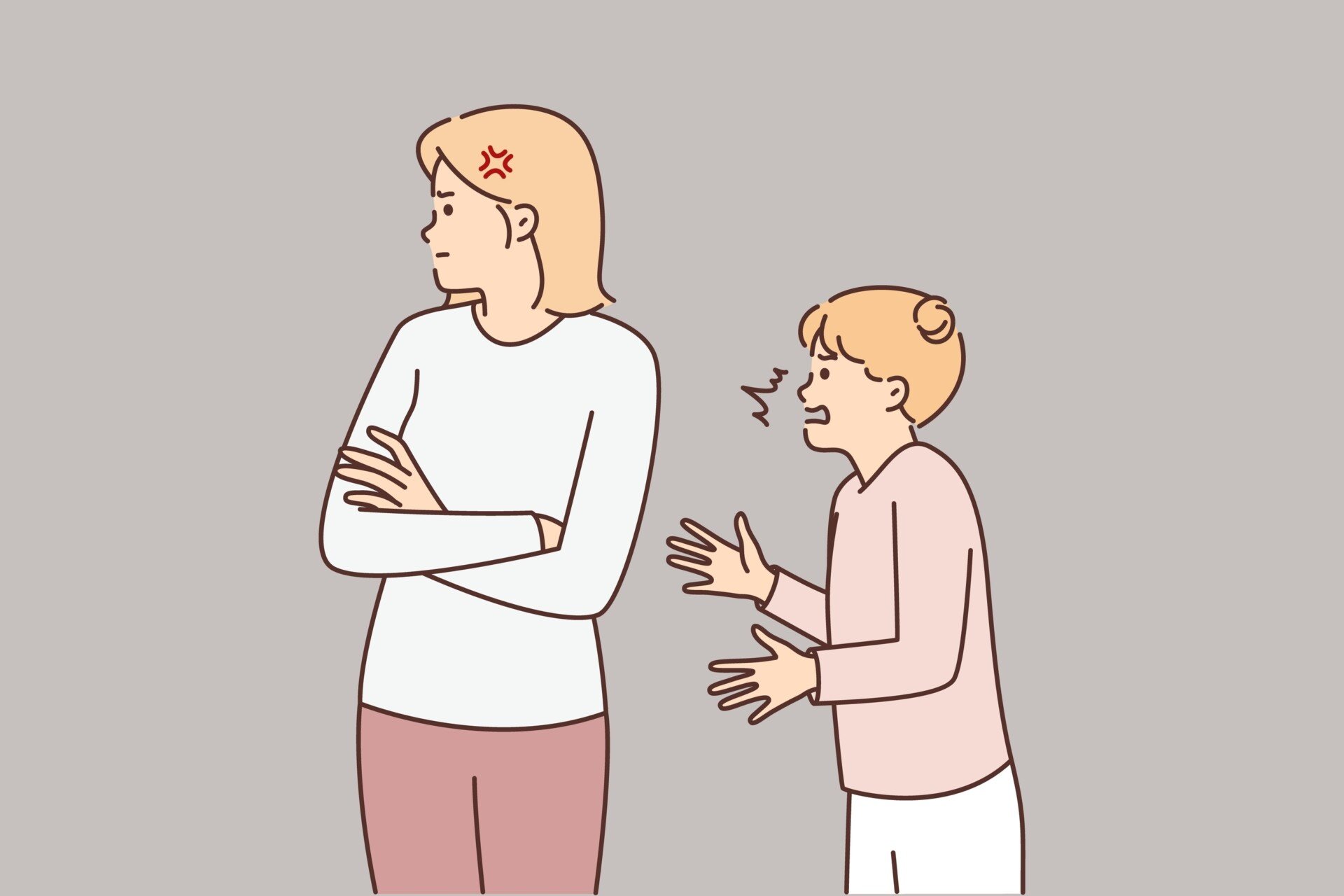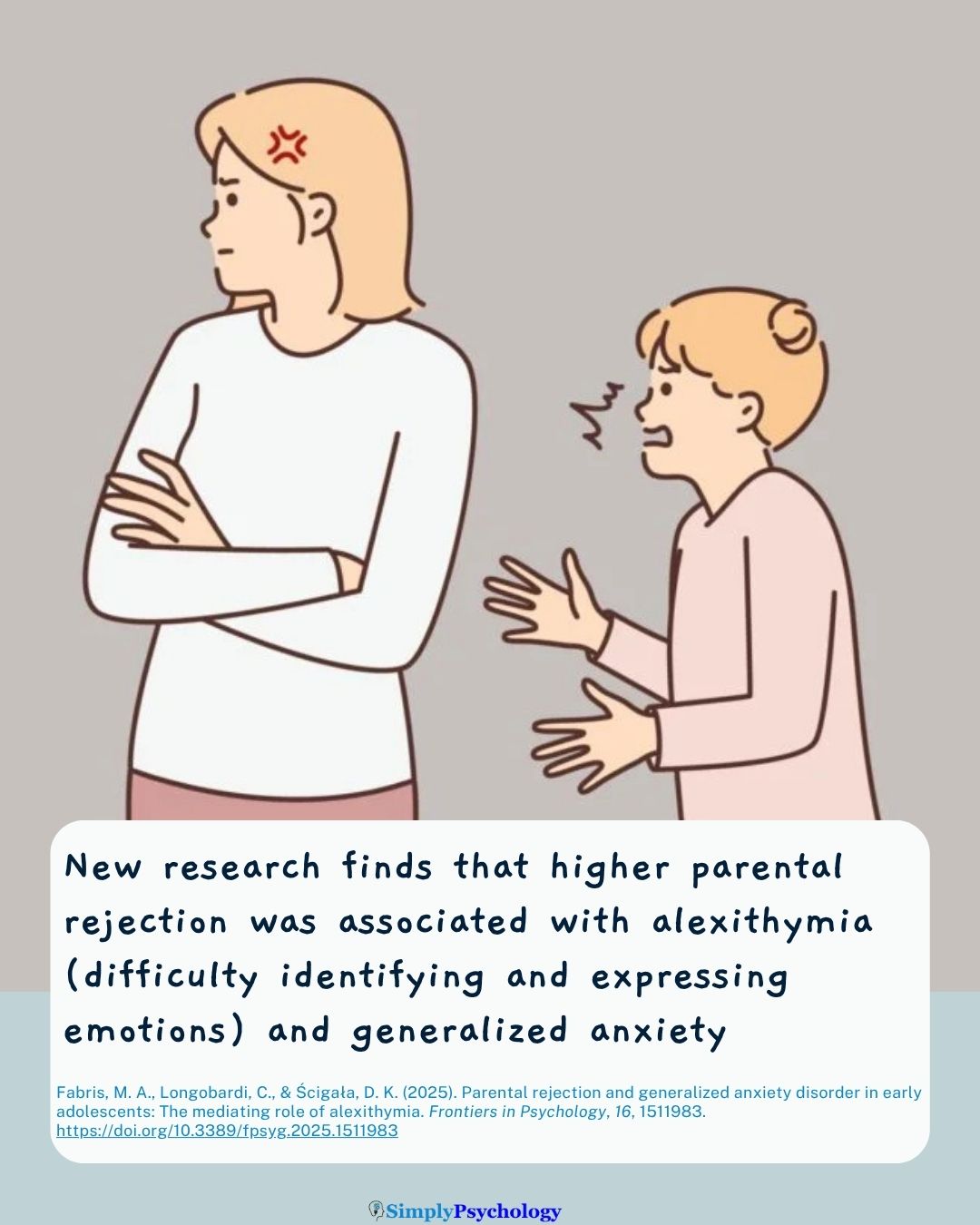Alexithymia is difficulty identifying and expressing emotions. Parental rejection involves cold, critical, or emotionally distant parenting.
When children experience rejection, they may not learn how to recognize or manage emotions, increasing the risk of alexithymia.
This emotional disconnect can make it harder to cope with stress, potentially leading to anxiety or other psychological difficulties.

Fabris, M. A., Longobardi, C., & Ścigała, D. K. (2025). Parental rejection and generalized anxiety disorder in early adolescents: The mediating role of alexithymia. Frontiers in Psychology, 16, 1511983. https://doi.org/10.3389/fpsyg.2025.1511983
Key Points
- Focus: The study investigates whether alexithymia mediates the relationship between perceived parental rejection (both maternal and paternal) and symptoms of generalized anxiety disorder (GAD) in early adolescents.
- Method: A cross-sectional survey of 234 Italian adolescents (ages 10–14) assessed self-reported experiences of parental rejection, alexithymia, and GAD symptoms using standardized questionnaires.
- Findings: Higher levels of parental rejection were associated with increased alexithymia and GAD symptoms. Alexithymia partially or fully mediated the link between parental rejection and GAD, especially through difficulty identifying and describing emotions.
- Implications: These findings highlight the importance of parent–child emotional dynamics and emotional regulation skills in adolescent mental health, with implications for targeted interventions.
Rationale
Early adolescence is a key developmental period marked by emotional and psychological changes.
Generalized anxiety disorder (GAD) often emerges during this stage and is linked to emotion regulation difficulties.
Prior research has shown associations between insecure parental relationships and anxiety, but few studies have investigated how specific parental behaviors, like rejection, relate to GAD via emotional processing deficits like alexithymia.
Alexithymia, defined by difficulties identifying and expressing emotions, has been associated with various internalizing disorders, including GAD.
The current study addresses a gap in understanding how alexithymia might serve as a mechanism linking parental rejection and GAD.
By examining both maternal and paternal influences and multiple dimensions of alexithymia, the research provides a nuanced view of potential pathways to adolescent anxiety, offering a foundation for more effective clinical interventions and prevention strategies.
Method
A quantitative, cross-sectional study design was used. Participants completed three validated self-report questionnaires measuring:
- Parental acceptance/rejection (separately for mothers and fathers)
- Alexithymia (four subscales)
- GAD symptoms
Data analysis included correlation matrices and multiple mediation models using the PROCESS macro in SPSS with bootstrapping (10,000 samples, 95% CI).
Procedure
- Recruitment: Adolescents were recruited from three middle schools in northwestern Italy.
- Consent: Parental consent and adolescent assent were obtained.
- Survey Administration: Participants completed the questionnaire at school under supervision.
- Instruments Used:
- Socio-demographic section
- Parental Acceptance-Rejection Questionnaire (PARQ)
- Generalized Anxiety Disorder 7-item scale (GAD-7)
- Toronto Alexithymia Scale (TAS-20)
- Data Analysis: Mediation analyses tested alexithymia’s role between parental rejection and GAD.
Sample
- Size: 234 adolescents
- Age: Mean = 11.86 years (SD = 0.93)
- Gender: 47% male (n = 110), 53% female (n = 124)
- Living Arrangements: 81% lived with both parents
- Region: Northwestern Italy (Piedmont and Lombardy)
Measures
- Parental Acceptance-Rejection Questionnaire (PARQ): 24-item scale for both maternal and paternal figures; higher scores reflect more acceptance (α = .84–.89).
- GAD-7: A 7-item screening tool for generalized anxiety symptoms; reliable in adolescents (α = .84).
- Toronto Alexithymia Scale – TAS-20 (Italian adolescent version): Assesses:
- Difficulty identifying feelings (DIF) – α = .89
- Difficulty describing feelings (DDF) – α = .70
- Externally oriented thinking (EOT) – α = .52
- Lack of subjective significance (LSS) – α = .51
Total score α = .77
Statistical Measures
- Descriptive statistics and Pearson correlations were calculated.
- Mediation models were tested using SPSS PROCESS macro (Model 4).
- Bootstrapping with 10,000 resamples and 95% confidence intervals was used to validate indirect effects.
Results
- Parental Rejection and Alexithymia: Higher parental acceptance correlated with lower alexithymia. Maternal acceptance showed slightly stronger associations than paternal.
- Parental Rejection and GAD: Both maternal and paternal rejection were positively associated with GAD symptoms.
- Mediating Role of Alexithymia:
- Total alexithymia partially mediated the maternal rejection–GAD link and fully mediated the paternal rejection–GAD link.
- Among alexithymia subscales, DIF and DDF were the strongest mediators for both parents.
- EOT was not significantly associated with GAD and was excluded from final models.
- LSS also showed partial mediation.
Insight
The study demonstrates that emotional unavailability from parents may impair children’s ability to understand and regulate their emotions, making them more vulnerable to anxiety.
Specifically, adolescents who feel rejected are more likely to develop alexithymic traits, such as difficulty identifying and articulating emotions.
This emotional confusion may promote excessive worrying as a maladaptive coping strategy, a hallmark of GAD.
These findings refine existing models by identifying alexithymia as a critical bridge linking early relational experiences to adolescent anxiety disorders.
Clinical Implications
- Parental Training: Educate parents on the emotional needs of adolescents and the harmful effects of rejection and criticism.
- Emotion-Focused Therapy: Interventions for adolescents with GAD should include modules on emotional literacy and regulation.
- Integrated Treatment: Address parental dynamics in therapy, particularly for adolescents showing signs of alexithymia.
- Preventive Work: Schools and pediatricians should screen for emotional expression difficulties and provide early support.
Strengths
This study had several methodological strengths, including:
- The study focuses on early adolescence, a key period for emotional development and anxiety onset.
- Separate analysis of maternal and paternal rejection adds specificity.
- Multidimensional approach to alexithymia allows for fine-grained understanding of emotional deficits.
- Bootstrapped mediation models offer robust statistical validation.
Limitations
This study also had several limitations, including:
- The cross-sectional design prevents causal conclusions about the direction of relationships.
- Self-report measures may reflect perception biases or be influenced by social desirability.
- The sample was not representative of the Italian adolescent population and was limited to community-based, non-clinical participants.
- The study did not include observational or clinical diagnostic data.
Socratic Questions
- Could adolescents with GAD symptoms perceive their parents more negatively than is warranted?
- How might the findings differ in a clinical sample diagnosed with GAD?
- Why might difficulty identifying emotions be more predictive of anxiety than an externally oriented thinking style?
- How might cultural expectations about maternal versus paternal roles shape adolescents’ perceptions of rejection?
- Can emotional regulation training in schools help buffer against the effects of parental rejection?
- If you were designing a longitudinal study to confirm causality, what would you include?
- How might interventions differ for adolescents showing only alexithymia versus those with both alexithymia and GAD?
- Could overprotective or enmeshed parenting also contribute to alexithymia in a different way than rejection?



